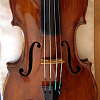
June 2012
Weekend vote: Do you have the opportunity to play in a group?
June 30, 2012 17:51I have found, with my students, that something very important for them is having the opportunity to play their instrument with other children, whether it's in Suzuki group class, school orchestra, youth orchestra or some other kind of regular playing situation. It's important for adults, as well, whether they are amateurs or professionals. If violin is just a solitary activity, it's hard to stay motivated to practice and improve. The problem is easily solved if you are in an orchestra, but it also may mean that you form a quartet, play chamber music, join in a Celtic music band, play at church -- there are many different ways to fulfill this near-universal need to make music with other people.
Do you have the opportunity to play in a group? And feel free to describe your group, or your feelings about this matter, below.
V.com weekend vote: Do you practice in one long session, or several short ones?
June 23, 2012 09:19Do you practice in one long session, or in several shorter ones, over the course of a day?
This week's interview with David Garrett made me think about this issue. He said that he spent much of his late teen years in pain, from injury. Part of his recovery involved switching to practicing in short sessions -- no longer than a half-hour at a time -- as well as changing his positioning, regular weight training and just taking control of his life in general. He said the short sessions were better physically, as well as mentally.
I confess, when I'm really on a tear, practicing for something, I'll go for a good hour and a half before stopping for a break. Three hours in a day has always been the max for me, though; call me a wuss. I've never been able to put in six-hour practice days; certainly not six hours in a row!
In general, do you practice in one long session, or several? What are your thoughts about the matter?
Weekend vote: How do your pegs affect your ability to tune your fiddle?
June 16, 2012 19:17When it comes to sticky, no-good, slipping, impossible-to-tune pegs, I've done my time.
My German violin -- companion through high school, college and beyond -- had such pegs. A few years after college, I had the peg box re-bushed, fixed so that we could cut new holes and install new pegs. Check out the pegs removed from the old fiddle:

Yes, I do believe those are four completely different kinds of pegs!
Not only did my early violin have problem pegs, but I also have taught scores of school children who were playing very cheap fiddles. And what makes a cheap fiddle cheap? One key ingredient is ill-fitting pegs.
Pegs can cause problems in a variety of ways. Traditional pegs mostly cause problems if they don't fit the holes drilled for them in the peg box. Perhaps the holes are just old and weirdly worn. I believe that was the case with my German fiddle. Perhaps they never fit, because no one ever tried for that level of precision. Such is the case with cheap fiddles. But another reason they can "not fit" has to do with changing temperatures and humidity levels, which can throw the different woods of the pegs and peg box out of whack by making one expand or contract more than the other. Thus a change in the weather or climate can cause pegs to go wacky and either slip easily or get sticky and difficult to turn.
Why am I thinking about pegs? I'm still getting over this new revelation that Elizabeth Pitcairn has installed Wittner Fine-Tune pegs in her Strad, something I learned Tuesday at a violin-testing event in Southern California. Strads are notoriously prone to climate-related malaise, and she said that this simple move to planetary pegs has alleviated considerably the tuning problems caused by the frequent climate change she faces when constantly traveling to play in different cities around the world. ("Planetary" refers to the peg's internal gear system, in which little gears orbit like planets around the drive shaft "sun" gear. Traditional pegs work by using friction -- in other words, they are just jammed into that hole, and if they slip, you just jam them further in.)
There are several kinds of planetary pegs; she uses Wittner, but there are also Perfection Pegs by Knilling (which do require that they be glued in; Wittners do not). If you have serious problems with pegs, some kind of modern planetary pegs could be a pretty nice solution.
At any rate, I am now curious about people's peg travails. I now have nice, workable pegs that are the traditional kind. But my struggles with bad pegs were a serious pain. And for a student, just learning to tune, it can be a major barrier. Where do you stand right now in relation to the pegs on the fiddle you most use?
V.com weekend vote: Does your violin playing cause you pain?
June 9, 2012 22:52I've said it before, and I'll say it again: the violin can be a pain in the neck!
Rather, it can cause a pain in the neck, or the upper back, or the arm, or the wrist, or the lower back, or maybe in your right big toe.
The fact is, it's one awkward instrument to play. For me, I tend to get quite the tight upper back, and I think my family members are getting mighty sick of my requests (demands?) for them to dig their elbows into my back to relieve the pain!
How about you? Does your fiddle playing cause you pain of any kind? And how do you alleviate or prevent it?
V.com weekend vote: Have you ever had trouble, flying with your violin?
June 1, 2012 11:25I recently faced the decision of whether or not to travel with my violin, and after hearing a lot of horror stories, I decided against it.
As it turned out, I probably could have brought my fiddle on my U.S. Airways flight with no problems; both a violin and a big guitar traveled as carry-ons, on the same flight as me. But others had scary stories about the same airlines. I did see that I would have likely needed to pay extra for early boarding, as all the overhead space filled fast.

It seems we musicians take a few steps forward and then a few backwards again with this issue.
On the positive side: this February, the U.S. Congress passed an FAA Bill of Rights for passengers, part of the FAA Air Transportation Modernization and Safety Improvement Act of 2012. The relevant part for us is Section 713, which "requires an air carrier to permit an air passenger to carry a violin, guitar, or other musical instrument on a passenger aircraft without charge if it can be stowed safely in a suitable baggage compartment in the aircraft or under a passenger seat." If you are concerned about traveling with your violin in the U.S., you might want to copy the bill and put it in the pocket of your fiddle case. Here it is for you to copy. You also might want to highlight Section 713.
While this seems like good progress, news from the U.K. has us going the other direction: a recent change in British Airways policy will effectively make it impossible to travel on that airline with a fiddle -- unless you'd like to put it in the hold (and you wouldn't).
What has been your experience, flying with your instrument? Have you ever had trouble with it? If you've had more than one of the bad experiences listed below, just check the one that was most memorable and then describe the others in the comments.
More entries: May 2012
Violinist.com is made possible by...
Dimitri Musafia, Master Maker of Violin and Viola Cases
Johnson String Instrument/Carriage House Violins
Subscribe
Laurie's Books
Discover the best of Violinist.com in these collections of editor Laurie Niles' exclusive interviews.

Violinist.com Interviews Volume 1, with introduction by Hilary Hahn

Violinist.com Interviews Volume 2, with introduction by Rachel Barton Pine






